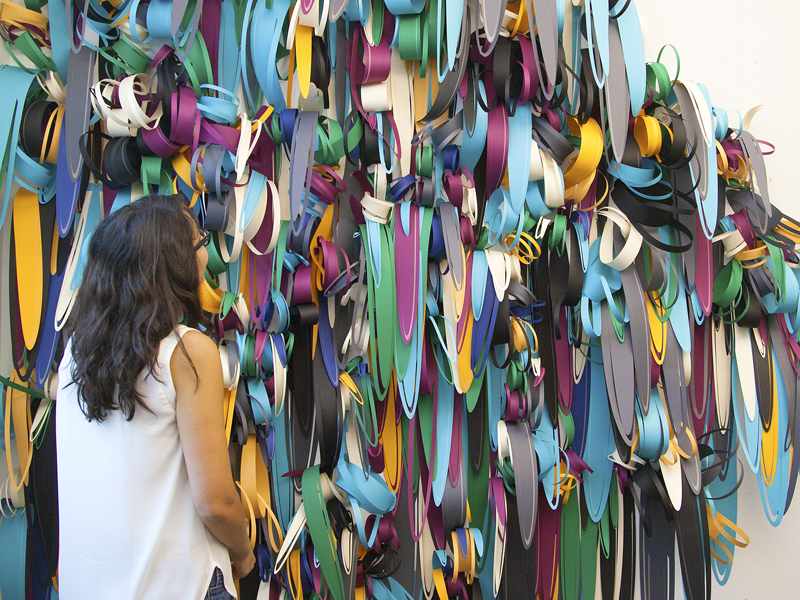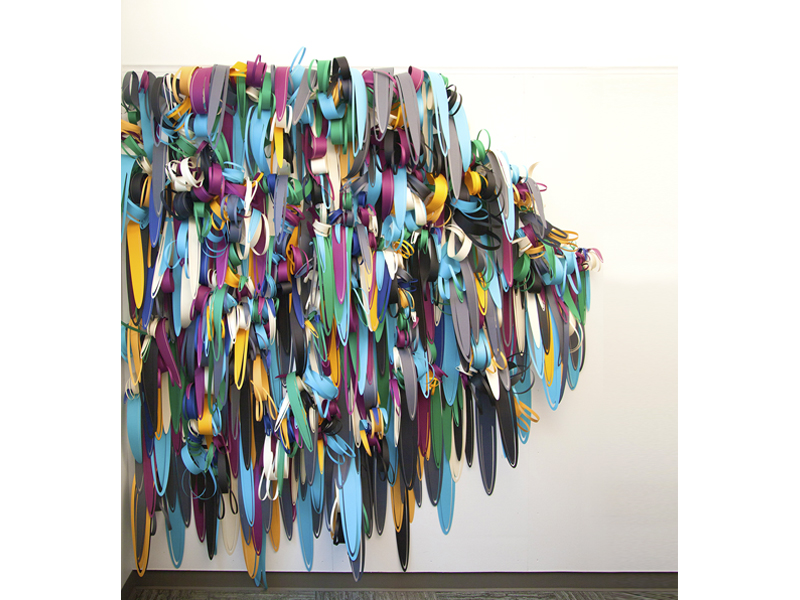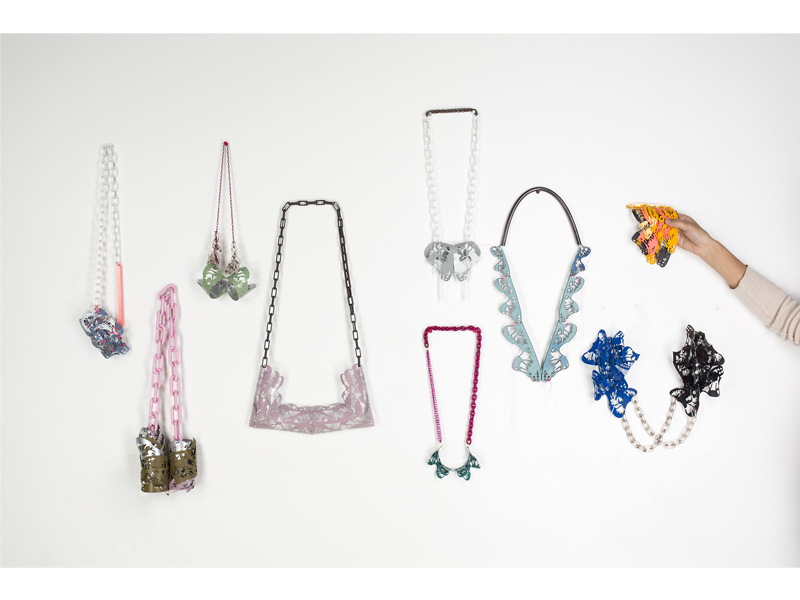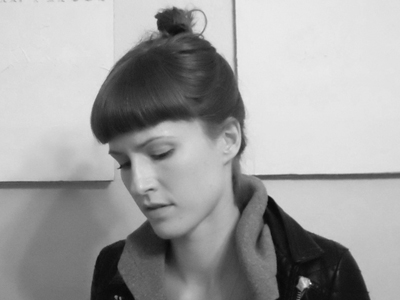
1.
For this final installment of the three-part series Beyond Unwearable, I would like to take a moment to reflect on the makers from my prior articles to give a richer view of the content of this third and final piece. In the first segment, we viewed Julia Heineccius’s Divisible installation, a piece that straddles installation art, a light form of participatory art, and sensitivities to architectural space, all while remaining rooted in the field of metalsmithing and jewelry. Heineccius’s considerations of the body moving through space, the subtleties of perception and peripheral vision, and her regard for the activation of a work with nothing more than the movement of the body through space ensure that this piece could have taken no other format but that of installation art. It divorces itself from wearable work while still retaining ties to our field through material and acknowledgment of the body as the “site” of action.
In the second segment, I paired Amelia Toelke’s Dragonfruit and Kristi Sword’s Quick Count Drawings to examine the surface, luster, and tactility of wall-based works that express the optical qualities of jewelry. Using symbols, surfaces, and construction techniques from the field of jewelry, these works utilize the language of adornment and the decorative object in ways that wearable work could not. A “jewelry lens” turned inward on the gallery itself, Toelke and Sword’s individual works adorn the body of the gallery and turn visitors into accessory witnesses to what it looks like to be worn, adorned, and decorated on a scale that dwarfs the body and celebrates space itself.
I hope this final installment brings a sense of conclusion to the series, a finale of sorts that opens the flood gates for more making, more exploration, and more conversation around the complex diversity with which emerging makers in our field are making. This is not a call for the creation of less wearable work or more jewelers-turned-sculptors, but rather a call to investigate the depth of content that is at the core of our field and accept expansive methods of making as critical to the development of craft.

2.
The most “jewelry-based” maker in this series is Lyndsay Rice. Her newest body of work, False Plumage, is a departure from her large-scale wearable works in format, but closely related to them in content. Rice’s previous wearable works, specifically a body of jewelry pieces titled Color Constructions, borrow patterned segments from Alexander McQueen’s 2010 garment collection that are then recolored, abstracted, and layered, paying subtle homage to McQueen’s iconography of insects, animal skins, and camouflage. If colors and patterns in the animal and insect kingdoms are used as an attractant or warning symbol, Rice’s oversized, glittered, and pop-culture-colored symbols seek to reposition what it means to attract in the contemporary moment.

False Plumage takes the strongest elements in Color Constructions and magnifies them. If ornamentation in nature is about the necessity of attracting mates or warning predators, what happens when ornamentation outgrows the body and infiltrates the environment around you? And what can an oversaturation of pattern, color, and ornamentation imply? Draping off of the wall in candy-colored sheets, fragmented textile patterns, now cut in thick paper, feel lush and overbearing. Subtle glints of neon and pastel hide inches below the natural recesses of the outer surface. The proliferation of cloned patterns seems to cover more of the gallery environment with each glance, mirroring nature’s unrelenting reproductive agenda.
The natural bends, flourishes, and arcs of the paper are softer than you expect and, similarly to Julia Heneccius’s net in Divisible and Kristi Sword’s Quick Count Drawings, the colored and patterned segments respond to your movements through the space by trembling and nudging into one another. The wall becomes an overactivated version of her wearable work, casting the viewer in the role of prey, to be enticed inward and enveloped inside thick layering. Where Rice’s Color Constructions emphasize beauty, adornment, and sexual reproduction, False Plumage extends beyond a single reference. It is at once an attractant and a threat; the uncomfortable density and blurring of color and shape feel beautiful, disorienting, and false. If there is a single work to exemplify the contradictory effects of ornamentation, this is it.
![[left] Lyndsay Rice, Untitled #1, from the Color Construction series, 2015, neckpiece, 330 x 533 x 51 mm, photo: Jim Escalante, [center] Lyndsay Rice, Untitled #4, from the Color Construction series, 2015, neckpiece, 495 x 152 x 76 mm, photo: Jim Escalante, [right] Lyndsay Rice, Untitled #7, from the Color Construction series, 2015, neckpiece, 165 x 127 x 51 mm, photo: Jim Escalante [left] Lyndsay Rice, Untitled #1, from the Color Construction series, 2015, neckpiece, 330 x 533 x 51 mm, photo: Jim Escalante, [center] Lyndsay Rice, Untitled #4, from the Color Construction series, 2015, neckpiece, 495 x 152 x 76 mm, photo: Jim Escalante, [right] Lyndsay Rice, Untitled #7, from the Color Construction series, 2015, neckpiece, 165 x 127 x 51 mm, photo: Jim Escalante](/sites/default/files/art_ckamp_wearability3_4_5_6_600x800px.jpg)
3.
As an emerging maker myself, I see the challenges of having a practice that cannot be easily defined. Jewelry and metalsmithing as a field can feel like a closed circuit for emerging makers when it pushes tradition, trend, and repetition over expansiveness. Is a jewelry work that resides upon the body inherently more relevant to our conversation than an installation-based work that explores human adornment, the body, or the history of our field? I argue it is not. Jewelers have something singular to say about the body, and about ornamentation, whether they do it on walls or on skin. While installation art has a rich and long history of its own, absorbing and repurposing installation-based methods of making is new to the jewelry field. The body, ornamentation, and our shifting perception of objects are at the crux of both wearable and installation works. Emerging makers—such as Heineccius, Toelke, Sword, and Rice—are using their understanding of body, scale, and adornment, and applying it to new explorations on walls, on floors, in spaces. The ability to view their works as jewelry, by expanding our notions of what jewelry can be, lets us develop new ways of experiencing our field as a whole. They are “question seekers,” looking for their questions and answers of how, why, and what it means to ornament in a multitude of media for the betterment of creative practice as a whole. The four makers represented in Beyond Unwearable are challenging the conversations of jewelry and wearability in diverse ways, each with their own questions for “you”: the viewer, the critic, the academic, the maker. In the quest to cultivate new conversations, I hope you answer the questions they pose with your own critical works, writings, and explorations.




